
Biology is the scientific study of life and living organisms. It explores key concepts such as cells, genetics, and ecosystems. Understanding biology is essential for addressing real-world challenges in medicine, agriculture, and environmental conservation. This study guide provides a comprehensive overview of fundamental biological principles, preparing students for success in their final exams by covering essential topics and practical study strategies.
1.1 Key Concepts and Themes
Mastering key biological concepts is crucial for exam success. Focus on understanding cells, genetics, evolution, and ecosystems. These themes form the foundation of biology, linking structure to function and explaining life processes. Key topics include cellular transport mechanisms, DNA replication, and energy flow in ecosystems. Practical skills, such as microscopy and experimental design, are also emphasized. By prioritizing high-weightage areas like human physiology and ecology, students can efficiently allocate study time. Utilizing flashcards and practice questions can reinforce memorization of terms and concepts, ensuring a comprehensive grasp of biology’s core principles.
1.2 Importance of Biology in Everyday Life
Biology plays a vital role in addressing real-world challenges, from medicine to agriculture and environmental conservation. Understanding biological principles helps solve issues like disease prevention, sustainable food production, and ecosystem management. Biology’s applications are evident in advancements like genetic engineering, biotechnology, and public health strategies. Studying biology fosters critical thinking and problem-solving skills, enabling individuals to make informed decisions about their health and the environment. By mastering key concepts, students can contribute to societal progress and develop innovative solutions for future challenges, making biology an essential and impactful field of study.

Cell Structure and Function
Cells are the basic structural and functional units of life. Understanding their structure, including membranes and organelles, is crucial for grasping biological processes like photosynthesis and respiration.
2.1 Cell Membrane and Transport
The cell membrane is a phospholipid bilayer with embedded proteins, regulating the movement of materials in and out of the cell. Passive transport, including diffusion, osmosis, and facilitated diffusion, allows substances to move without energy. Active transport requires energy to transport molecules against concentration gradients. Understanding these mechanisms is crucial for cellular function. Study tips include using flashcards for key terms and practicing questions on transport types. Focus on how these processes maintain cellular homeostasis and support overall organism function.
2.2 Cell Organelles and Their Roles
Cell organelles perform specialized functions essential for cellular survival. The nucleus houses DNA and regulates gene expression. Mitochondria generate ATP through cellular respiration. Ribosomes synthesize proteins, while the endoplasmic reticulum processes proteins and lipids. Lysosomes contain digestive enzymes for breaking down waste. The Golgi apparatus modifies and transports proteins and lipids. Centrioles organize microtubules for cell division. Chloroplasts, found in plants, conduct photosynthesis. Peroxisomes detoxify and break down fatty acids. The cytoskeleton provides structural support and aids in transport. Each organelle’s role is vital for maintaining cellular homeostasis. Studying their functions using diagrams and concept maps can enhance understanding of cellular processes.
2.3 Cellular Processes: Photosynthesis and Respiration
Photosynthesis and cellular respiration are vital cellular processes. Photosynthesis occurs in chloroplasts, using light energy to convert CO2 and water into glucose and oxygen. This process supports life by providing energy and organic molecules. Cellular respiration, occurring in mitochondria, breaks down glucose and oxygen to produce ATP, CO2, and water. It is a critical energy-converting process. Both processes are interdependent, with photosynthesis supplying oxygen and respiration using it. Understanding their stages, such as light-dependent reactions and the citric acid cycle, is essential. Diagrams and equations, like 6CO2 + 6H2O → C6H12O6 + 6O2 and C6H12O6 + 6O2 → 6CO2 + 6H2O, aid comprehension.

Genetics and Heredity
Genetics and heredity explore how traits are inherited and expressed. Key concepts include DNA structure, genes, and Mendelian inheritance patterns. Understanding these principles is fundamental for analyzing genetic disorders and advancements in biotechnology.
3.1 DNA Structure and Replication
DNA’s double helix structure consists of two strands of nucleotides, each containing a sugar, phosphate, and nitrogenous base. Adenine pairs with thymine, and guanine pairs with cytosine through hydrogen bonds. DNA replication is semiconservative, meaning each new strand is synthesized from an original template; Enzymes like helicase unwind DNA, while DNA polymerase adds nucleotides to form complementary strands. This process ensures genetic continuity, maintaining identical DNA copies in daughter cells. Understanding replication mechanisms is crucial for studying genetic inheritance and molecular biology techniques.
3.2 Mendelian Laws of Inheritance
Mendelian laws, discovered by Gregor Mendel, explain how genetic traits are inherited. The Law of Segregation states that alleles separate during gamete formation, ensuring each gamete receives one allele. The Law of Independent Assortment describes how different genes independently separate into gametes. The Law of Dominance explains that a dominant allele will mask a recessive one in heterozygous organisms. These principles, observed in pea plant experiments, form the foundation of genetics. They predict patterns of inheritance, such as 3:1 and 9:3:3:1 ratios, and are essential for understanding genetic crosses and trait inheritance in organisms.
3.3 Genetic Engineering and Biotechnology
Genetic engineering involves the manipulation of DNA to alter genetic traits in organisms. Techniques like CRISPR and restriction enzymes enable precise modifications. Biotechnology applies these tools to develop medical treatments, such as insulin production and gene therapy. Crops are engineered for improved yields and pest resistance. Advances in cloning and synthetic biology expand possibilities. Ethical considerations arise, including concerns about GMO safety, privacy, and equitable access. Biotechnology revolutionizes industries, offering solutions to global challenges while sparking debates on its societal and environmental impacts.
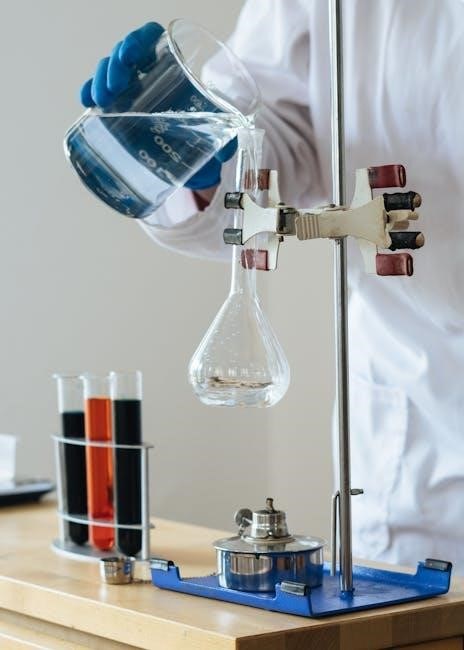
Evolution and Natural Selection
Evolution explains how species adapt and change over time through natural selection, genetic drift, and mutation. It drives biodiversity and shapes life on Earth.
4.1 Mechanisms of Evolution
Evolution occurs through key mechanisms: natural selection, genetic drift, mutation, and gene flow. Natural selection favors traits enhancing survival and reproduction, driving adaptation. Genetic drift alters allele frequencies randomly, influencing diversity. Mutations introduce new traits, while gene flow transfers genetic material between populations. These processes collectively shape evolutionary change, leading to species divergence and biodiversity. Understanding these mechanisms is crucial for grasping how life evolves over time.
4.2 Evidence for Evolution
The evidence for evolution is vast and comes from multiple fields. The fossil record shows a clear pattern of gradual changes in life forms over time. Comparative anatomy reveals homologous structures, indicating shared ancestry. Molecular biology confirms this through DNA and protein similarities. Biogeography explains the geographic distribution of species, while embryology shows parallels in early development. Additionally, observable evolutionary changes in populations and the presence of vestigial structures further support the theory. Together, these lines of evidence provide a robust framework for understanding evolutionary processes.
4.3 Speciation and Phylogeny
Speciation is the process by which new species emerge, often due to reproductive isolation. Allopatric speciation occurs when geographic barriers divide populations, while sympatric speciation happens without physical separation. Phylogeny studies the evolutionary relationships among organisms, represented in phylogenetic trees. These trees are constructed using shared derived traits, molecular data, and fossil records. Cladistics groups organisms based on shared characteristics, revealing common ancestry. Speciation and phylogeny together explain biodiversity and the history of life on Earth, showing how species diverge and evolve over time due to natural selection and genetic drift.
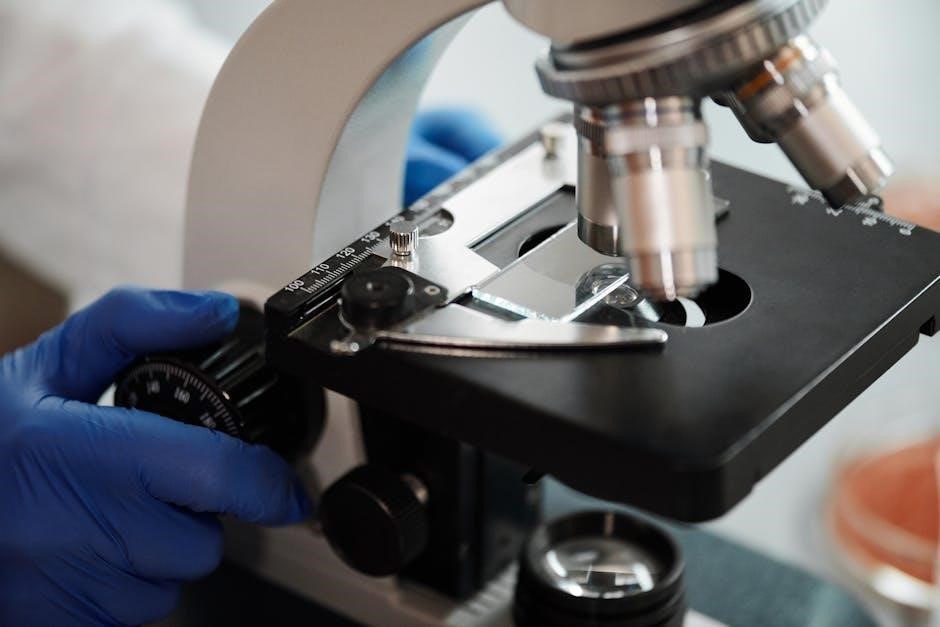
Ecology and Ecosystems
Ecology studies interactions between organisms and their environment, focusing on energy flow, nutrient cycles, and biotic-abiotic relationships within ecosystems. It explores how species adapt, compete, and influence biodiversity.
5.1 Population Dynamics and Community Interactions
Population dynamics involve the study of factors influencing population size, such as birth rates, death rates, immigration, and emigration. These dynamics often follow exponential or logistic growth patterns, shaped by resource availability and environmental constraints. Community interactions, including predator-prey relationships, competition, and symbiosis, play a crucial role in maintaining ecosystem balance. Keystone species and mutualistic relationships can significantly impact biodiversity. Understanding these interactions helps explain how communities adapt and evolve, ensuring the stability of ecosystems. These concepts are vital for analyzing ecological health and predicting responses to environmental changes.
5.2 Energy Flow and Nutrient Cycles
Energy flows through ecosystems in a unidirectional manner, beginning with producers who capture sunlight via photosynthesis. This energy is transferred to consumers at each trophic level, with only about 10% passing to the next level due to metabolic costs. Decomposers return energy to the environment as heat. Nutrient cycles, such as carbon, nitrogen, and phosphorus, sustain life by recycling essential elements. Producers absorb nutrients from the soil, which are then passed through food webs and returned via decomposition. Understanding these cycles is critical for managing ecosystems and maintaining biodiversity, as they regulate the availability of resources for all organisms.
5.3 Human Impact on the Environment
Human activities significantly alter ecosystems, often leading to environmental degradation. Pollution from industrial waste and fossil fuels disrupts air and water quality, harming organisms and ecosystems. Deforestation and land-use changes reduce biodiversity and habitat availability. Climate change, driven by greenhouse gas emissions, alters temperature and weather patterns, affecting species distribution and extinction rates. Overexploitation of resources, such as overfishing and mining, depletes populations and damages ecosystems. Understanding these impacts is crucial for developing conservation strategies and sustainable practices to mitigate environmental damage and preserve biodiversity for future generations.

Human Physiology
Human physiology examines how the body functions, integrating the nervous, circulatory, respiratory, digestive, and excretory systems to maintain health through processes like oxygen delivery and nutrient absorption.
6.1 Nervous and Endocrine Systems
The nervous system, comprising the central and peripheral nervous systems, transmits signals through neurons, enabling communication and control of bodily functions. The endocrine system produces hormones like insulin and adrenaline, regulating metabolism, growth, and stress responses. Both systems interact to maintain homeostasis, such as blood sugar levels, through feedback loops. The hypothalamus acts as a bridge, linking neural signals to hormone release. Understanding these systems is crucial for grasping human physiology, as they orchestrate responses to stimuli and internal changes, ensuring overall bodily harmony and adaptation to environmental demands.
6.2 Circulatory and Respiratory Systems
The circulatory system, led by the heart, transports oxygen and nutrients via blood vessels to cells and removes waste. The respiratory system, involving lungs and airways, exchanges oxygen and carbon dioxide through breathing. These systems collaborate to deliver oxygen to tissues and expel carbon dioxide. The alveoli in lungs facilitate gas exchange, while hemoglobin in red blood cells carries oxygen. Their coordination ensures proper oxygenation and waste removal, vital for energy production and overall health.
6.3 Digestive and Excretory Systems
The digestive system breaks down food into nutrients through mechanical and chemical processes. Organs like the mouth, esophagus, stomach, and intestines play roles in ingestion, digestion, and absorption. The excretory system removes waste, with the kidneys filtering blood to produce urine. The liver detoxifies substances, and the pancreas regulates blood sugar. Skin aids in waste removal through sweating. These systems ensure nutrient uptake, waste elimination, and maintenance of homeostasis, essential for energy production, growth, and overall bodily function.
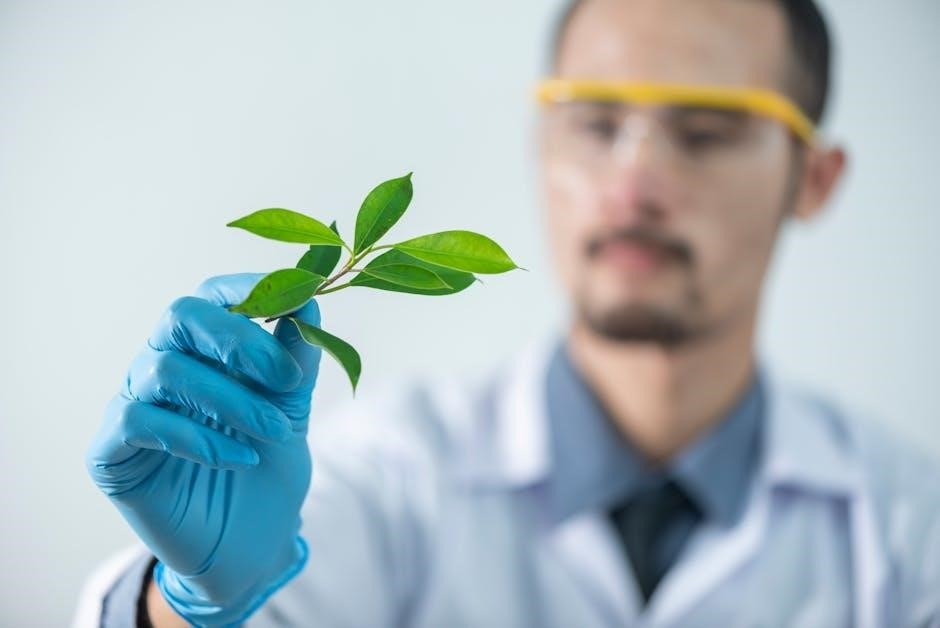
Plant Biology
Plant biology examines the structure, growth, and function of plants, including photosynthesis, transport systems, and responses to stimuli. It explores development from seeds to mature organisms.
7.1 Plant Structure and Growth
Plant structure and growth involve root and shoot systems, with roots anchoring plants and absorbing nutrients, while shoots support leaves for photosynthesis. Stems and branches provide structural support and transport nutrients and water. Leaves are specialized for photosynthesis, with tissues like mesophyll and veins optimizing light absorption and resource distribution. Growth occurs in meristems, regions of undifferentiated cells producing new tissues. Primary growth elongates plants upward and downward, while secondary growth thickens stems and roots. Understanding plant anatomy and developmental processes is crucial for comprehending how plants adapt to environments and sustain life through efficient nutrient and water transport systems.
7.2 Photosynthesis and Transpiration
Photosynthesis occurs in chloroplasts, converting light energy into chemical energy via the Calvin cycle, producing glucose from CO2 and water. Chlorophyll absorbs light, driving electron transport chains to generate ATP and NADPH. Transpiration, the loss of water vapor through stomata, cools plants and maintains water flow. Stomatal opening is regulated by environmental factors like light, CO2, and humidity, controlled by guard cells. Both processes are essential for plant survival, balancing energy production and water conservation. Understanding these mechanisms is vital for grasping plant physiology and ecosystem functioning.
7.3 Plant Hormones and Responses
Plant hormones regulate growth, development, and responses to environmental stimuli. Auxins promote cell elongation and root formation, while gibberellins enhance germination and stem elongation. Cytokinins stimulate cell division and leaf growth, and ethylene triggers fruit ripening. Abscisic acid induces stomatal closure and stress responses. Tropisms, like phototropism and gravitropism, occur due to hormone redistribution. Environmental factors, such as light, gravity, and stress, influence hormone production and distribution, enabling plants to adapt. Understanding hormone interactions is crucial for explaining plant behavior, growth patterns, and adaptive strategies.
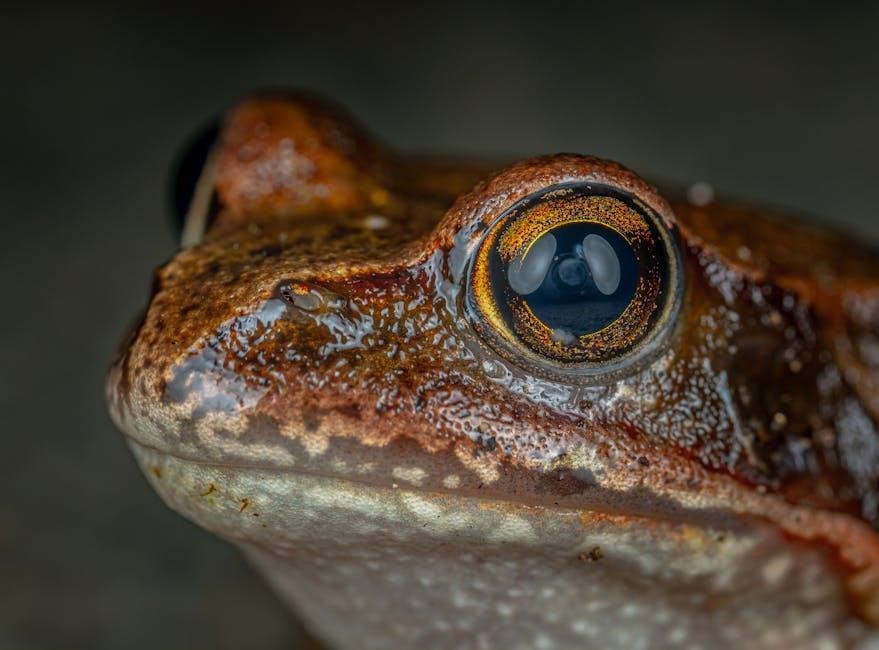
Study Strategies for Success
- Engage in active learning through discussions and teaching others.
- Use spaced repetition for long-term retention of material.
- Incorporate diagrams and flashcards to visualize concepts.
- Set specific, achievable goals for each study session.
- Practice past papers under timed conditions to build exam stamina.
8.1 Effective Note-taking and Review Techniques
Effective note-taking is crucial for retaining biological concepts. Use methods like the Cornell Method or outline notes to organize information. Highlight key terms and concepts in real-time. After class, review and summarize notes within 24 hours to reinforce memory. Use flashcards or concept maps to visualize relationships between ideas. Prioritize active recall by testing yourself on the material without notes. Regularly review notes by skimming and focusing on headings, bullet points, and summaries. Experiment with different colors or symbols to categorize information, making it easier to locate during study sessions. Consistency is key to building a strong foundation for exam success.
8.2 Time Management and Exam Preparation
Effective time management is essential for biology exam success. Create a study schedule that balances topics and allows regular breaks to avoid burnout. Prioritize challenging concepts and allocate more time to mastering them. Use a planner or digital calendar to track deadlines and progress. Practice with past papers or mock exams to simulate test conditions. Review and analyze mistakes to improve understanding. Stay organized by grouping similar topics together and using visual aids like timelines or charts. Ensure a restful night’s sleep before exams to maintain mental clarity and focus. Consistency and discipline in study habits will significantly enhance performance.
8.3 Using Flashcards and Practice Questions
Flashcards are a powerful tool for memorizing key biology terms and concepts. Write the term on one side and the definition or explanation on the other. Use them regularly to reinforce memory. Practice questions help apply knowledge and identify weak areas. Start with simple questions and progress to more complex ones. Spaced repetition systems can enhance long-term retention. Practice exams simulate real test conditions, improving time management and reducing anxiety. Review incorrect answers to understand mistakes. Highlight and revisit challenging topics. Consistency in using these tools ensures a strong foundation for exam success.
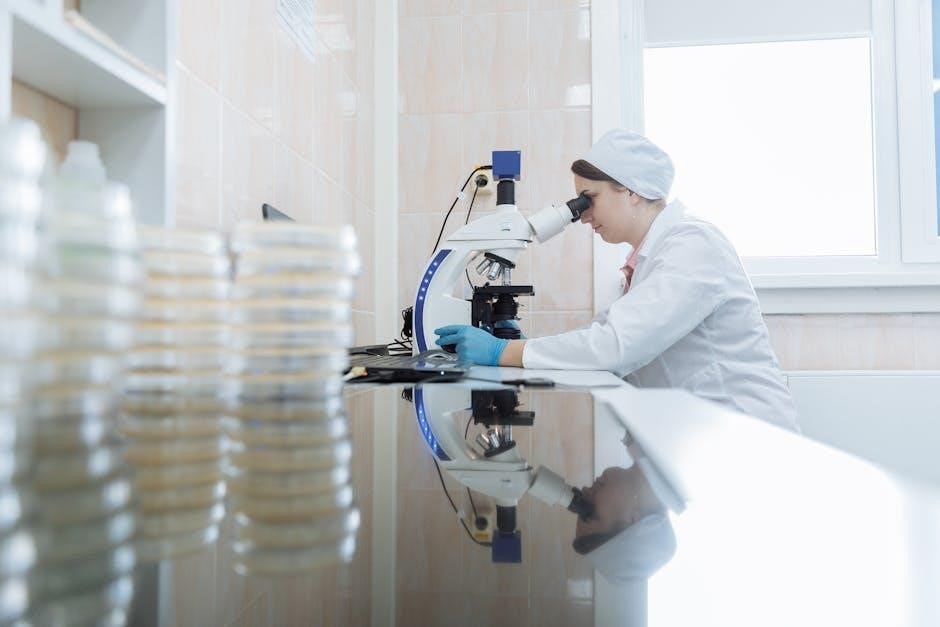
Key Biological Processes
This section explores essential biological processes, including enzyme function, metabolic pathways, and homeostatic mechanisms. It highlights how these processes maintain life and regulate bodily functions.
9.1 Enzymes and Biochemical Pathways
Enzymes are biological catalysts that accelerate chemical reactions in cells, enabling essential metabolic processes. They lower activation energy, making reactions occur efficiently. Each enzyme binds to specific substrates via its active site, ensuring high specificity. Factors like temperature, pH, and inhibitors regulate enzyme activity. Biochemical pathways, such as glycolysis, involve enzyme-mediated reactions that convert substrates into products. These pathways are crucial for energy production, biosynthesis, and degradation of molecules. Understanding enzyme kinetics and regulation is vital for grasping metabolism and cellular function. Key examples include amylase, lactase, and ATP synthase, which play roles in digestion, sugar metabolism, and energy production.
9.2 Homeostasis and Regulation
Homeostasis is the ability of organisms to maintain a stable internal environment despite external changes. It involves regulatory mechanisms that detect and respond to deviations, ensuring optimal conditions for cellular functions. Negative feedback loops are central to homeostasis, reversing changes to restore balance, while positive feedback amplifies changes to achieve specific outcomes. The nervous and endocrine systems play key roles, with hormones like insulin and glucagon regulating blood sugar levels. Thermoregulation and osmoregulation are critical examples, maintaining body temperature and fluid balance. Disruption of homeostasis can lead to disease, highlighting its importance in overall health and survival.
9.3 Immune System and Disease
The immune system is the body’s defense against pathogens and diseases. It comprises two main components: innate immunity, which provides immediate, non-specific defense through barriers and cells like macrophages, and adaptive immunity, offering specific, long-lasting protection through lymphocytes. Diseases arise from immune system failures, such as autoimmune disorders where the body attacks itself, immunodeficiencies that weaken defense, and allergies caused by overreactions. Understanding immune mechanisms is crucial for developing treatments like vaccines and immunotherapies to combat infections and diseases.

Practical Skills and Lab Techniques
Mastering microscopy, experimental design, and data analysis are essential for biological investigations. These skills enhance understanding, precision, and preparation for real-world scientific applications.
10.1 Microscopy and Cell Identification
Microscopy is a cornerstone of biological research, enabling the study of cells and microorganisms invisible to the naked eye. Light microscopes are commonly used for routine observations, while electron microscopes provide higher resolution for detailed structures. Cell identification relies on staining techniques, such as Gram staining for bacteria or histological stains for tissue sections. Understanding cellular morphology and specialized structures aids in distinguishing cell types and their functions. Proper sample preparation and focusing techniques are essential for accurate observations. Mastery of microscopy enhances diagnostic and analytical skills in biology and medicine.
10.2 Experimental Design and Data Analysis
Experimental design is critical in scientific inquiry, ensuring controlled variables and valid results. A well-structured experiment includes clear hypotheses, independent and dependent variables, and appropriate controls. Data collection involves precise measurements using tools like spectrophotometers or timers. Analysis often employs statistical methods to test hypotheses, such as t-tests or chi-square tests. Graphs and charts visualize trends, aiding interpretation. Accurate documentation and replication enhance reliability. Understanding experimental design and data analysis fosters critical thinking and problem-solving skills, essential for scientific research and real-world applications in biology. These skills are vital for interpreting and presenting experimental outcomes effectively.
10.3 Safety Protocols and Lab Procedures
Laboratory safety is paramount to prevent accidents and ensure a secure environment. Essential protocols include wearing personal protective equipment (PPE) like lab coats, gloves, and goggles. Chemical handling requires reading labels carefully, using fume hoods, and proper disposal. Biological safety involves proper handling of microorganisms and disposal of sharps. Emergency procedures, such as knowing the location of fire extinguishers and eyewash stations, are critical. Students must follow lab rules, avoid eating or drinking, and keep long hair tied back. Adhering to these protocols minimizes risks and fosters a responsible and efficient learning environment. Always follow instructor guidance for specific procedures.